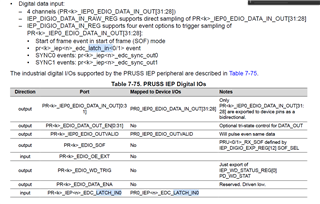Tool/software:
Hi all!
Am looking for more detail on the PRU IEP timer, specifically registers & bitfields.
I've found the Datasheet, Technical Reference Manual & the header file at; pru-icss/6.3.0-r0/git/include/am62x/pru_iep.h
Within the PDFs I've found IEP timer references but not a register description, hopefully I've missed something obvious.
I note that the header file differs from others e.g. the pru_iep.h headers for k2g, am571x, am335x, am437x, am572x all contain a definition for CMP0_RST_CNT_EN but there doesn't appear to be one for the am62x?








